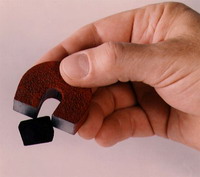Login form
Magnets
 Hold a refrigerator magnet close to your refrigerator door. Let go of it. If you are close enough to the refrigerator, the magnet will jump across empty space and stick to the refrigerator. This action might seem kind of mysterious. But it makes sense when you know what magnetism is.
Hold a refrigerator magnet close to your refrigerator door. Let go of it. If you are close enough to the refrigerator, the magnet will jump across empty space and stick to the refrigerator. This action might seem kind of mysterious. But it makes sense when you know what magnetism is.
Magnetism is an invisible force. Magnetic force can attract (pull toward) or repel (push away). Magnetism comes from magnets. Magnets make things move without touching them. Some magnets are weak. Other magnets are much stronger.
Some rocks, such as lodestone, are natural magnets. Iron and some other metals can be made into magnets. Cloth, rubber, plastic, and many other things cannot be made into magnets.
SHAPES OF MAGNETS
Some magnets are shaped like the letter U. Some magnets are shaped like bars. Magnets can also be thin disks, squares, or rectangles. Other magnets are round or have irregular shapes.
Magnets can be big or small. Earth is a giant magnet. The Sun, stars, and some other planets are also magnets. Atoms can be magnets. Atoms are tiny bits of matter much too small to see.
NORTH AND SOUTH POLES
The important thing to remember about a magnet is that it has two ends called poles. One end is called the north pole, and the other end is the south pole. The south pole of one magnet will attract and stick to the north pole of another magnet. The south pole of a magnet will repel, or push away, the south pole of another magnet. North poles will also repel each other.
MAGNETIC FIELDS
Hold the north pole of one magnet close to the south pole of another magnet. Don’t let them touch. You can feel the magnets tugging toward each other. Now try to bring the north poles of both magnets together. You can feel the magnets pushing away from each other.
Magnets are surrounded by magnetic fields. You feel magnetic pull or push inside the magnetic field. Move the magnets farther apart. The pull feels weaker. The farther you go from a magnet, the weaker its magnetic force becomes. Magnetic fields are strong close to a magnet and weak far away. If you hold the magnets far enough from each other, you will not feel them pull at all.
MAKING A MAGNET
Long ago, people in Greece, Rome, and China found that lodestone could pull iron toward it. Lodestone is made of the mineral magnetite. When they rubbed a piece of iron with lodestone, the iron became a magnet, too. People in ancient times did not know it, but rubbing made tiny magnets inside the iron all line up in the same direction. All the north poles were pointed the same way. So were the south poles.
In the 1200s, sailors learned how to make a compass that could help them find their way at sea. They made a needle from a thin piece of lodestone or iron. They hung the needle from a string. The needle always pointed north. Because Earth is a big magnet, the south pole of the compass needle always points toward the magnetic North Pole of Earth. Remember, the south pole of one magnet always pulls toward the north pole of another magnet. This works whether the magnet is as small as a needle or as big as a planet.
In the 1800s, people learned that magnetism is related to electricity. They learned how to make magnets by winding electric wire around a piece of iron. These magnets are called electromagnets.
PERMANENT AND TEMPORARY MAGNETS
Permanent magnets always have magnetic force. Lodestone is a natural permanent magnet. Other permanent magnets can be made from mixtures of metals such as iron and nickel.
Temporary magnets are made from materials that must be inside a magnetic field to have magnetism. Electromagnets are temporary magnets because they must have electricity to work. Electromagnets cannot pick up heavy loads if the electricity is turned off.
Some materials can never be turned into magnets. These materials include cotton, glass, paper, plastic, rubber, and wood.
HOW WE USE MAGNETS
You can use a magnet for holding notes and pictures on your refrigerator door. But people use magnets for many other things. Radios and TVs need magnets in order to work.
Electric motors need electromagnets. Electric motors drive many appliances in your home. There are electric motors in washing machines, vacuum cleaners, fans, and many other things. Electric motors also drive big machines in factories. They drive engines in some trains and ships. Big magnets in electric generators help make the electricity you use in your home.
Huge electromagnets can pick up heavy loads. Some electromagnets can even lift cars. Electromagnets also make a powerful type of microscope, called an electron microscope, work.
Magnetic materials can store information. Videotapes and computer hard drives use tiny magnets to record information.
Doctors use machines with powerful magnets to make pictures of the inside of the body. These pictures are made by a method called magnetic resonance imagining (MRI).
Scientists and engineers are working on trains that float above the track. Magnets in the train and track push away from each other to lift the train a short distance above the track. These floating trains are called magnetic levitation, or maglev, trains.
Source: Microsoft ® Encarta

